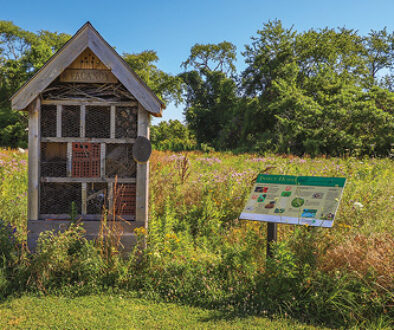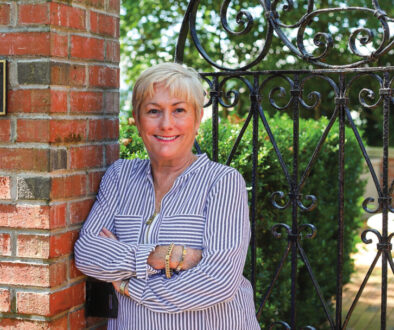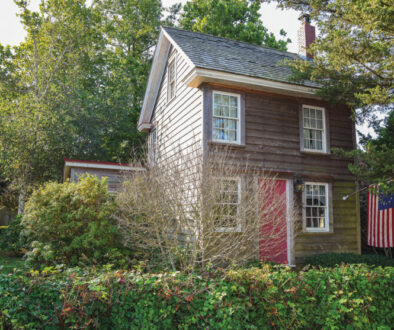The Philadelphia Factor
How the City of Brotherly Love impacted Cape May’s development
The year is 1801. Ellis Hughes Sr., a carpenter who purchased 75 acres along the beachfront and the old Cape Island Road (today’s Jackson Street) from his son Thomas H. Hughes in 1796, has secured a tavern license. But few people know about the sea bathing, food, or health benefits available at Cape Island. Ellis’s house is one of only two island boarding houses, the other being the slightly larger house of Ephraim Mills, a Delaware River boat pilot who, with his wife Mary, is able to accommodate 10 or 12 boarders. People find out about the island by word of mouth, often through those Cape May Delaware River pilots who guide boats from the mouth of the bay on the Atlantic Ocean to Philadelphia. Travelers come down the river from Philadelphia in sloops or by road on stage coaches. The primary reason to make the somewhat arduous trip is for the sea bathing that is believed to improve one’s health and cure various maladies or illnesses.
Ellis places what is believed to be the first advertisement referring to Cape May as a seashore resort by promoting his accommodations in the July 1801 Philadelphia Aurora. The number of visitors do not appear to increase substantially; Mills and Hughes advertise together to promote their boarding houses throughout July 1810 in the Philadelphia True American and Commercial Daily Advertiser: “The subscribers inform their friends and customers that they still keep their boarding houses as before and expect that they shall be able to give satisfaction….Cooks and waiters, and also the best wines and other liquors are provided from Philadelphia.” Despite these efforts to increase visitors, no other boarding houses or accommodations are opened until after 1815, when Ellis’s son Thomas is licensed by the court to operate an inn or tavern in the “house wherein he now dwells in the Lower Township in Cape Island.” Undoubtedly the War of 1812 (which lasted until 1815) influenced visitors, since British ships frequently landed to raid Cape May farms for food and water and sabotaged American ships in the Delaware Bay and off the Coast of Cape Island.

By mid-century, Cape Island achieves its first tourism heyday. In those decades, many local residents built, developed, or were proprietors of a variety of accommodations, as well as the stores and amenities needed to support tourism. The primary clientele were no longer people visiting for health reasons, but people who came to have fun. Nor were the visitors any longer primarily Philadelphians, but included people from southern cities such as Baltimore, Richmond, and Washington, D.C., and other communities throughout the South. Southern visitors could travel to Delaware City or to New Castle, Delaware by land to board the steamships that stopped on their routes between Philadelphia and Cape May. Within Cape May County, Dennis Creek (today’s Dennisville, in the northwest corner of the county) and Cape Island (in the southeast corner) were the county’s two largest and most industrious communities. By 1850, Cape Island was no longer a small settlement whose economy was based on Delaware River pilots, farmers, and fishermen; tourism had become a primary economy. Of the 19 wealthiest men in the county, 10 lived in Cape Island, including Jonas Miller, Israel Leaming, George Hildreth, and Jerimiah McCray—all local citizens who built and owned the larger hotels.
Thomas Hughes opened the first large hotel on the Island in 1816, initially called Hughes’s or the Large House, and eventually named Congress Hall. By 1828 there were a number of other smaller hotels or boarding houses along Perry or Jackson Streets, jointly advertised by their proprietors in the Baltimore Gazette and Daily Advertiser: “To such as may not have visited Cape May, it may be proper to state that this place possesses peculiar advantages in having a fine surf, with little or no undercurrent, which renders it particularly safe for ladies and children.” They went on to describe an additional advantage of “a first rate fishing Smack, with an experienced commander, to ply between the Island and the Bank, a distance of about 3 hours sailing, for the amusement of such as are fond of fishing and to ensure a regular supply of fish in perfection.” The proprietors operated the Atlantic (Bennett and Mackenzie), Congress Hall (J. B. Hughes), and two small hotels/boarding houses (Humphrey Hughes and Eli Wales).


In 1832, county native Richard Smith Ludlam resettled to Cape Island from his Dennis Creek home and built the island’s second largest hotel. The Mansion House had accommodations for 200 guests and was the first Cape Island hotel with plaster walls. In an 1833 ad announcing the hotel’s opening in the Baltimore American and Commercial Daily Advertiser, Henry Kitchen, proprietor, stated that “everything attached to the house is calculated to promote comfort, health, and happiness; first rate servants, commodious apartments, a variety of recreations and amusements, a band of music, a piano, and good beds and bedding.” That same year, Israel Leaming built the smaller Ocean House on the east side of Perry opposite Congress Hall. Cape May tourism had officially expanded into resorting for pleasure and amusement rather than solely for health.
In response to ever-expanding tourism needs, many Cape May residents developed, built, or expanded boarding establishments and hotels; others simply rented rooms in the summer. For many, this summer income supplemented year-round earnings while for others, tourism was the primary income. Year-round residents advertised in the Philadelphia and Baltimore papers just like the larger houses and hotels, noting that private boarding was available in their homes. The demand for accommodations exceeded supply. Hotels and boarding houses generally did not take reservations. Visitors would scramble off the steamships at the landing (approximately where Sunset Beach is today) and onto wagons that carried them into town, hoping to get there before others and in time to secure rooms. Despite the need for rooms during the bathing season, only three larger hotels—the New Atlantic (1842), Columbia House (1846), and United States Hotel (1850)—were built.


Originally developed by Cape May residents, both the Atlantic and Columbia properties were eventually sold to Philadelphians. Ellis Hughes’ Atlantic House was purchased in 1839 by the McMakin brothers, Joseph and Benjamin, who were well-known steamboat owners and captains. They renamed the hotel the Old Atlantic when, in 1842, the brothers built the very much larger New Atlantic. The Columbia House, built by Cape May’s Captain George Hildreth, was sold to a group of Philadelphia investors in 1864. Although this sale was the group’s first purchase in Cape Island, John Bullitt, Frederick Fairthorne, and Peter McCollum developed many speculation houses and other projects over the following decades.
The United States Hotel deserves special mention because it was built by Philadelphian Ayres W. Tompkins, who was also its proprietor, and it was the first architect-designed hotel on Cape Island (although the Columbia House was updated in 1864 by Stephen Decatur Button, Cape May’s most prolific architect). Philadelphia architect Napoleon LeBrun, known for other notable buildings in both Philadelphia and New York, such as Philadelphia’s Academy of Music and the Cathedral of St. Peter and St. Paul, designed the building. After the Civil War, he moved his family to New York and became one of the city’s most prominent architects. Around 300 guests could be accommodated in this most beautiful and ornate building. After opening in the summer of 1850, at least three fires occurred there, all of which were successfully extinguished. In November, the arsonist, who was a disgruntled waiter, was apprehended, and no more fires occurred until the massive 1869 fire that burned not only the United States but many other buildings.

The townspeople were often skeptical of the larger hotels, believing that rooms would not be filled or that projects were too financially risky for other reasons. Throughout the 1840s, more than 10 smaller establishments were built and operated by townspeople, including the American, Cape May, Centre, Commercial, Delaware, Franklin, Madison, and New Jersey Houses and White Hall, all of which accommodated around 100 visitors each. By 1850, Cape Island’s hotels increased to more than five large (Atlantic and New Atlantic, Columbia House, Congress Hall, Mansion House, and United States Hotel) and nearly 20 small hotels and boarding houses, a majority of which were financed and operated by Cape May citizens. Surveyor Philip Nunan recorded a thriving Cape Island in an 1850 map showing the names and locations of properties bordered by drawings of the prominent hotels, churches, and notable summer resident’s houses. The Nunan map shows the heavy concentration of tourist accommodations in the three blocks between Perry and Ocean and from Washington to the beachfront, all of which were crowded during the six to eight-week bathing season, but deserted the remainder of the year.
Cape Island was continuing to grow, but through the addition of outside investors, who by 1850 were beginning to overtake and change local investment patterns. By 1846, the Banneker House, catering exclusively to African Americans, was opened on Lafayette Street. The House was named for Benjamin Banneker, an African American from Baltimore who was renowned for his mathematical knowledge. In 1852, a group of Philadelphia investors began construction of the colossal Mount Vernon Hotel, reported to be the largest hotel in the world, with a capacity of over 2,100 guests. When it opened in 1854 without both wings yet finished, 1,000 guests were accommodated in rooms with running water and gas lights—firsts for Cape Island. The Mount Vernon was not totally completed before it burned in 1856. Several months later, the Mansion House also burned. Neither hotel was rebuilt, resulting in a loss of 2,400 rooms. In the succeeding decade, few new hotels would be built, and Cape Island would struggle to remain a vibrant resort.

The railroad to Atlantic City had been completed in 1852, eliminating Cape Island’s transportation-by-water advantage. Philadelphians and anyone else who could connect to the railroad could travel to Atlantic City quickly and economically. And, to make matters worse, the country was embroiled in discussions about slavery, which ultimately reduced the number of summer visitors from the South. When the Civil War started in 1861, travel from the South to Cape May was virtually impossible, and southern summer visitors did not return in any great numbers after 1865 when the war ended. Many Philadelphians (and others) profited dramatically from the war, resulting in many newly wealthy people who brought their money to Cape May by building summer cottages, now more popular than staying in large hotels or boarding houses. Others financed and became developers of projects such as streetcars, race tracks, and other amusements.
What was sorely lacking were large numbers of summer visitors; outside investors believed that could be fixed by building a railroad from Philadelphia to Cape May. The need for a railroad was controversial among townspeople, some of whom supported it and others who thought that a railroad would impact negatively on the town and its economy. In the end, Philadelphia investors provided both the impetus and the support needed to complete the line, which began operating in the summer of 1863. The train forever intertwined Philadelphia with Cape May by decreasing the isolation of the county’s citizens and opening up new economic opportunities. The railroad’s investors sought ways to promote train travel and, in turn, the townspeople found ways of catering to the summer visitor. The first major undertaking of railroad investors was to fill in marshland east of Ocean Street in 1868 to build the large Stockton Hotel and its associated cottages to lure Philadelphia visitors. How else would they get to Cape Island but by train?

After the War’s end, Cape Island’s economic future was very much in the hands of outside investors, many of whom were wealthy Philadelphians such as E. C. Knight, Jacob Neafie, William Sewell, Stephen Smith, Richard Wood, and others who made large fortunes through Civil War industries and became land purchasers and developers. But prosperity was limited by two major fires—the one in 1869 and a second in 1878. The 1869 fire burned most properties between Jackson and Ocean Streets including the United States Hotel. Almost 10 years later, everything between Washington Street and the beachfront and Perry and Ocean Street was burned, including many of the earlier hotels such as Congress Hall and the Columbia House, creating opportunities for new development financed by Philadelphia money. Throughout the late 18th and early 19th century, hotels originally built by Cape May residents were purchased and operated by Philadelphians, including Samuel Marcy’s White Hall. Purchased in 1911 by Edward Dale, White Hall was renamed the Dale Hotel and operated as a premier hotel for African Americans. By this time, Philadelphians had substantially taken over Cape May economically and in numbers, at least during the summer months. They not only were the largest group of summer residents—well outnumbering the 1,200 year-round townspeople—but, through land speculation, development, property ownership, and other investments, they had taken over the town’s economy. Cape May townspeople depended on Philadelphia money to support a tourism economy. After this devastating fire, it would take the investment of many outsiders, primarily from Philadelphia, to rebuild the resort to once again attract summer visitors.


White Hall illustration from the Nunan map; Hotel Dale postcard courtesy of Richard Gibbs.
Throughout the years, Philadelphia money would continue to support land and property investment, as well as underwrite many town infrastructure and summer amusement projects, taking over Cape May’s tourist economy. But perhaps the ultimate “Philadelphia takeover” was pulled off by one Philadelphia woman, who with the assistance of several summer resident cottagers, successfully had Cape May listed on the National Register in 1970 and, in 1976, designated as a National Landmark—all in addition to completing property surveys that became a basis for obtaining Housing and Urban Development (HUD) funds. Those HUD-funded projects included the Washington Street Mall, the park, promenade, parking, and other major projects. At the time, townspeople were generally against both any historic designation and any use of federal funds, worried that designation would affect future development and tax ratables, and that federal funding would come with too many strings.

But this is a Philadelphia takeover that we all should applaud, because without the tenacity and commitment of Carolyn Pitts, a Philadelphia architectural historian who went on to work for the National Park Service, and others who joined with her, we would not have Cape May looking—and thriving—as it does today.



